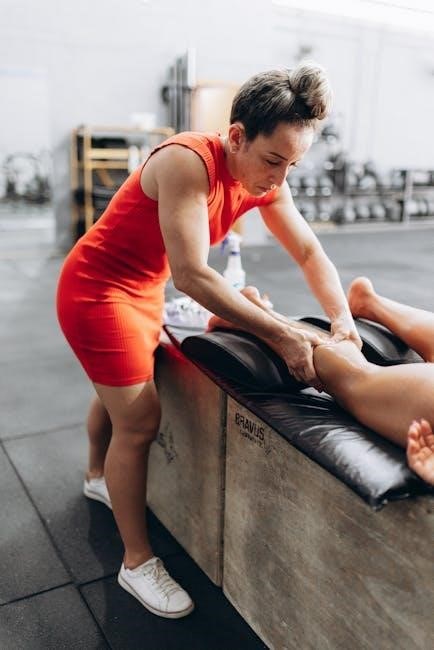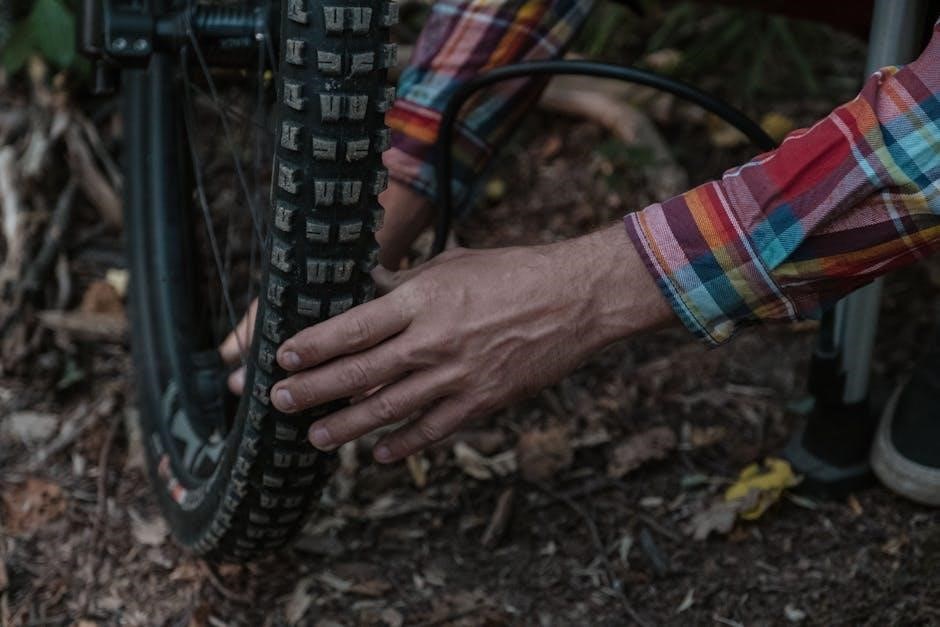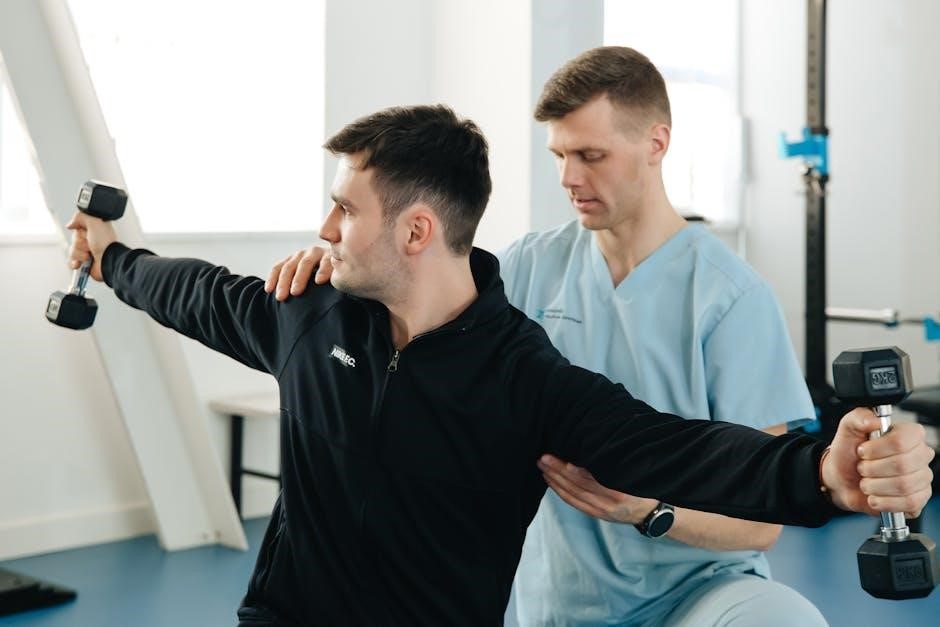
A BMX manual trainer is a specialized tool designed to help riders master the art of manualing, which involves balancing on the rear wheel․ This device enhances balance, stability, and rear wheel control, making it an essential training aid for BMX enthusiasts looking to improve their skills and confidence before attempting advanced tricks․
1․1 What is a BMX Manual Trainer?
A BMX manual trainer is a specialized device designed to help riders master the manual, a fundamental BMX skill involving balancing on the rear wheel․ It typically consists of a frame or mechanism that stabilizes the bike, allowing riders to practice rear-wheel lifts and balance without the risk of falling․ This tool is especially useful for beginners, as it provides a controlled environment to build core BMX skills before transitioning to real-world riding scenarios․
1․2 Importance of Manual Training in BMX Riding
Manual training is crucial for BMX riders as it enhances balance, coordination, and overall bike control․ Mastering the manual allows riders to perform advanced tricks and navigate various terrains with confidence․ It strengthens core muscles and improves reaction time, essential for maintaining stability at high speeds․ Manual training also lays the foundation for more complex skills, making it a vital component of any BMX rider’s training regimen․

Benefits of Using a BMX Manual Trainer
A BMX manual trainer enhances balance, stability, and rear wheel control, while boosting confidence for advanced tricks․ It helps riders master fundamental skills efficiently and safely․
2․1 Improving Balance and Stability
The BMX manual trainer is designed to enhance balance and stability by allowing riders to practice manualing in a controlled environment․ By stabilizing the rear wheel, the trainer enables riders to focus on subtle shifts in their center of gravity, improving overall bike control․ This targeted practice helps develop the muscle memory needed for maintaining balance, making it easier to transition to real-world scenarios․ The trainer’s design ensures a safer learning curve, reducing the risk of falls while mastering this fundamental skill․
2․2 Enhancing Rear Wheel Control
The BMX manual trainer excels at improving rear wheel control by providing a stable platform for riders to practice balancing and manipulating the bike․ Its design allows riders to focus on subtle movements, enabling better control over the rear wheel’s position and angle․ Regular practice with the trainer enhances the ability to make precise adjustments, ensuring smoother transitions and more controlled maneuvers․ This targeted training helps riders develop the skill and confidence needed to master advanced techniques on various terrains․
2․3 Building Confidence for Advanced Tricks
The BMX manual trainer is instrumental in building riders’ confidence, allowing them to progress to advanced tricks․ By mastering balance and rear wheel control, riders gain the assurance needed to attempt more complex maneuvers․ The trainer’s stability provides a safe environment to practice, reducing the fear of failure and fostering a mindset ready for challenging techniques․ Consistent practice with the trainer bridges the gap between basic skills and advanced tricks, empowering riders to tackle new challenges with confidence․

How to Choose the Right BMX Manual Trainer
Selecting the right BMX manual trainer ensures effective training․ Look for stability, suitable size, and additional features to enhance your learning experience and skill progression․
3․1 Key Features to Look For
When selecting a BMX manual trainer, prioritize durability, stability, and adjustability․ Look for a sturdy frame, smooth-rolling wheels, and a wide base for better balance․ Adjustable height and angle settings allow customization to suit different skill levels and riding styles․ Additional features like foldability for easy storage and portability are also beneficial․ Ensure the trainer is compatible with your bike’s size and type․ Reading user reviews and feedback can provide insights into the product’s performance and reliability․
3․2 Top Models Available in the Market
Popular BMX manual trainers include the Tacx Vortex Smart, known for its ANT+ FE-C compatibility and automated resistance; The KICKR Bike stands out as a high-end option with advanced smart features․ The Enduro 3 is praised for its extended battery life and durability․ These models are favored for their innovative technology, sturdy construction, and ability to simulate real-world riding conditions․ Each offers unique advantages, catering to different rider preferences and skill levels, ensuring effective training and skill progression for BMX enthusiasts․
Setting Up and Using the BMX Manual Trainer
Assemble the trainer, calibrate resistance, and sync with devices for real-time feedback․ Start with short sessions, focusing on balance and gradually increasing difficulty as confidence grows․
4․1 Step-by-Step Setup Guide
Unbox and assemble the BMX manual trainer, ensuring all parts are securely attached․ Place the bike on a level surface and tighten the frame into the trainer․ Adjust resistance settings to match your skill level․ Ensure proper tire alignment with the roller and check for any play in the rear wheel․ Lower the bike onto the trainer and test stability by gently rocking the bike․ Finally, do a short test ride to confirm everything is secure and functioning smoothly․
4․2 Tips for Getting Started
Start on flat ground for better stability and gradually move to inclines as confidence grows․ Keep your body weight centered and knees slightly bent to maintain balance․ Practice lifting the front wheel by shifting your weight backward slowly․ Focus on smooth, controlled movements and avoid jerky actions․ Begin with short sessions to build muscle memory and gradually increase duration as skills improve․ Stay relaxed and keep your eyes on the horizon for better focus and control․
Common Mistakes to Avoid
Overcompensating with body weight and ignoring proper foot placement are common errors․ These mistakes can hinder progress and lead to loss of balance․
5․1 Overcompensating with Body Weight
One of the most common mistakes when using a BMX manual trainer is overcompensating with body weight․ Riders often lean too far back or forward, disrupting balance․ This can lead to loss of control and difficulty in maintaining the manual position․ Instead, focus on subtle weight shifts and keep your center of gravity aligned with the bike․ Practice small adjustments to build stability and avoid relying on excessive movements, which can hinder progress and make mastering manuals more challenging․
5․2 Ignoring Proper Foot Placement
Ignoring proper foot placement on the BMX manual trainer is a common mistake that can hinder progress․ Incorrect positioning can lead to poor balance, making it harder to maintain the manual․ Riders should ensure their feet are centered on the pedals and weight is evenly distributed․ Avoid placing too much weight on the heels or toes, as this can cause instability․ Proper foot placement is crucial for control and stability, so always check your position before starting and adjust as needed during practice․

Maintenance and Care
Regular cleaning and lubrication of the BMX manual trainer are essential to ensure smooth operation and longevity․ Inspect and replace worn parts to maintain optimal performance․
6․1 Regular Cleaning and Lubrication
Regular cleaning and lubrication are vital for maintaining your BMX manual trainer․ Use a soft cloth to wipe down the frame and moving parts, removing dirt and grime․ Apply a high-quality lubricant to pivot points and hinges to ensure smooth operation․ Avoid over-lubricating, as it can attract dust․ Consistent maintenance prevents rust and wear, keeping your trainer in top condition for effective training sessions․
6․2 Adjusting and Replacing Parts
Regularly inspect and adjust your BMX manual trainer’s components to ensure optimal performance․ Tighten bolts and screws as needed, and check for worn-out parts like bearings or pivot pins․ If a part is damaged or excessively worn, replace it promptly using compatible replacements․ Proper adjustment prevents instability, while timely replacements avoid potential breakdowns․ Always follow the manufacturer’s guidelines for adjustments and replacements to maintain your trainer’s functionality and safety․
Safety Precautions
Always wear protective gear, including helmets and pads, when using a BMX manual trainer․ Ensure the practice area is clear of obstacles and soft surfaces for falls․
7․1 Wearing Protective Gear
Protective gear is crucial when using a BMX manual trainer․ A helmet is essential to safeguard the head from impacts․ Knee and elbow pads protect joints from abrasions․ Wrist guards can prevent injuries from falls․ Properly fitting gear ensures safety and confidence while training․ Always check gear for wear and tear before each session․ Wearing protective gear minimizes injury risks, allowing riders to focus on mastering their balance and control without unnecessary distractions․
7․2 Choosing a Safe Practice Area
Selecting a safe practice area is vital for effective and injury-free training․ Opt for a flat, open space with a smooth surface, such as a skate park or empty parking lot․ Avoid areas with obstacles, uneven terrain, or loose debris․ Ensure good visibility and sufficient space to maneuver without colliding with objects or people․ Choose a surface like concrete or asphalt for better traction․ Always check for potential hazards and ensure the area is free from traffic and distractions․ Proper lighting is also essential for visibility during early morning or evening sessions․ Lastly, confirm that the location allows BMX training to avoid any disruptions or legal issues․
Real User Experiences and Reviews
Real users praise the BMX manual trainer for its effectiveness in improving balance and rear-wheel control․ Riders report significant progress in mastering manuals and building confidence․
8․1 Success Stories from BMX Riders
Many BMX riders have shared their success stories with the manual trainer, highlighting its effectiveness in improving balance and stability․ One rider mentioned mastering the manual within weeks, while another credited the trainer for helping them land their first-ever manual․ Several users noted how the trainer boosted their confidence, allowing them to transition smoothly to real-life riding scenarios․ These testimonials underscore the trainer’s role in accelerating skill development and fostering progression in BMX riding․
8․2 Common Feedback and Suggestions
Users often highlight the effectiveness of the BMX manual trainer in improving balance and control, though some note it requires consistent practice․ A few riders suggest starting with shorter sessions to build stamina․ Feedback also includes requests for more adjustable height settings to accommodate different bike sizes․ Overall, the consensus is positive, with many recommending it as a valuable tool for mastering manuals․ Riders emphasize the importance of patience and gradual progression when using the trainer․

Advanced Techniques to Master
Mastery involves transitioning manuals into dynamic riding scenarios and seamlessly integrating them into complex tricks․ Riders can refine their skills by practicing fluid transitions and precise control during maneuvers․
9․1 Transitioning to Real-Life Scenarios
Transitioning manual skills to real-life scenarios involves applying learned balance and control in dynamic environments․ Riders can practice manuals on various terrains like trails or streets, gradually increasing difficulty․ This process builds adaptability and confidence, enabling smooth integration of manuals into everyday riding; Consistent practice in real-world settings helps riders master the ability to maintain control while navigating obstacles, enhancing their overall BMX performance․
9․2 Incorporating Manuals into Tricks
Incorporating manuals into tricks enhances creativity and skill in BMX riding․ Riders can combine manuals with spins, flips, or grinds for unique combinations․ Practicing transitions between manualing and other tricks builds fluidity․ Start with basic tricks like nose manuals or wheelie tricks, then progress to more complex moves like manual 180s․ Consistent practice and patience are key to mastering these advanced techniques, ensuring smooth execution and control during performances or casual rides․
The BMX manual trainer is a valuable tool for enhancing balance, stability, and rear wheel control․ It builds confidence and prepares riders for advanced techniques, making it an essential asset for BMX enthusiasts of all levels to elevate their skills․